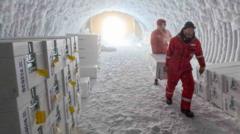What Secrets Will 1.5 Million-Year-Old Ice Reveal When It Melts?

Unlocking Earth's Climate History: The Significance of Ancient Ice Cores
The recent arrival of an ice core in the UK, potentially older than 1.5 million years, marks a monumental opportunity for scientists studying Earth's climate. Extracted from the depths of the Antarctic ice sheet, this ancient ice holds a treasure trove of information that could fundamentally alter our understanding of climate change. Researchers at the British Antarctic Survey (BAS) in Cambridge are preparing to melt this ice core, which may reveal critical insights into the planet's climatic past and help predict its future.
The Journey of the Ancient Ice Core
Drilled from the Antarctic ice sheet, this ice core is a remarkable specimen, encapsulating thousands of years of environmental data. The extraction process was a multinational effort, requiring meticulous planning and coordination among various research institutions. The ice core was transported in cold storage conditions to ensure its preservation, eventually arriving at the BAS where scientists are poised to analyze it.
Extraction and Transportation
The extraction of this ice core was no simple task. It involved:
- Drilling deep into the Antarctic ice sheet to obtain a core approximately 2.8 kilometers long.
- Chopping the core into 1-meter sections for easier handling and transport.
- Transporting these sections by boat and cold van to maintain the integrity of the samples.
Engineer James Veal, a key figure in this operation, described the experience as awe-inspiring, emphasizing the responsibility of handling such ancient material with care.
The Scientific Process of Melting and Analyzing the Ice
Once the ice core reached the BAS, it was placed in a -23°C freezer room designed to preserve its unique properties. Scientists, clad in protective gear, will carefully melt the core over a period of seven weeks. This slow melting process is essential to preserve the integrity of the samples, allowing researchers to extract valuable information without contamination.
Unveiling Secrets of the Past
As the ice melts, it will release ancient dust, volcanic ash, and tiny marine algae known as diatoms. These components are crucial for reconstructing historical climate conditions. Specifically, they can provide insights into:
- Wind Patterns: Understanding how wind patterns have changed over millennia can help scientists predict future climatic shifts.
- Temperature Fluctuations: Analyzing temperature variations over time can shed light on natural climate cycles.
- Sea Levels: Insights into past sea levels can inform current concerns regarding rising tides and coastal erosion.
Investigating Past Carbon Dioxide Levels
One of the most significant findings from the ice core may relate to carbon dioxide concentrations. According to Dr. Liz Thomas, the head of ice core research at BAS, there is evidence suggesting that carbon dioxide levels may have been naturally high over 800,000 years ago. This discovery is vital in understanding how Earth's climate system responds to increased greenhouse gas concentrations.
Implications for Today's Climate Crisis
The current climate crisis differs from historical periods of high greenhouse gases due to the unprecedented rate at which humans have contributed to these levels over the last 150 years. By comparing today's conditions with those of the past, scientists hope to garner essential insights into potential future scenarios as our planet grapples with climate change.
Understanding the Mid-Pleistocene Transition
Another intriguing aspect of the research revolves around a significant climatic event known as the Mid-Pleistocene Transition. Occurring between 800,000 and 1.2 million years ago, this period marked a shift in glacial cycles from a 41,000-year rhythm to a more erratic 100,000-year cycle. This transition remains one of the most compelling unsolved questions in climate science.
Diving Deeper into Climate Changes
By analyzing the isotopes and chemical signatures released from the melting ice, researchers will be able to:
- Identify rare earth elements and marine components.
- Understand the impact of volcanic eruptions on climate.
- Investigate how past environmental changes have influenced the planet's glacial cycles.
The Role of Ice Cores in Climate Science
Ice cores are pivotal in reconstructing Earth's climate history. They act as natural archives, preserving evidence of atmospheric conditions over millennia. The findings from these ancient ice samples not only contribute to our understanding of past climates but also serve as a crucial tool in shaping future climate policies.
Potential Outcomes of the Research
The research team is optimistic that their work will yield valuable data. Key expected outcomes include:
- Enhanced understanding of historical climate systems and their dynamics.
- Insights into how past climatic events can inform current climate resilience strategies.
- Data that could help predict future climate patterns based on historical trends.
The Importance of Multinational Collaboration
The successful extraction and analysis of this ice core exemplify the importance of international collaboration in climate research. Scientists from various countries have come together to tackle one of the most pressing challenges facing humanity today—climate change. This cooperative effort underscores the need for a unified approach to understanding and addressing global environmental issues.
Conclusion: A Glimpse into the Future
The melting of this ancient ice core may unlock a wealth of information about Earth’s climate history, providing essential insights that could shape our understanding of future climate scenarios. As researchers delve into the data contained within, the hope is that it will guide humanity in navigating the uncharted territory of climate change. With each drop of melted ice, we come closer to understanding the delicate balance of our planet's climate system.
Frequently Asked Questions
What is an ice core, and why is it important?
An ice core is a cylindrical sample of ice drilled from ice sheets or glaciers. It contains layers of ice that have accumulated over thousands of years, preserving atmospheric gases, dust, and other climatic indicators. Studying ice cores is crucial for understanding past climate conditions, which helps predict future climate scenarios.
How do scientists analyze the data from ice cores?
Scientists analyze ice cores by melting them slowly to extract trapped gases, dust, and other materials. They use specialized instruments, such as inductively coupled plasma mass spectrometers (ICPMS), to measure various elements and isotopes, providing insights into past temperatures, wind patterns, and atmospheric composition.
What can we learn about past climate events from ice cores?
Ice cores can reveal information about historical temperature fluctuations, greenhouse gas concentrations, volcanic activity, and sea level changes. By studying these factors, scientists can better understand the natural cycles of Earth's climate and the impact of human activity on current climate change.
The journey of this ancient ice core is just beginning, and it promises to be a pivotal chapter in our quest to understand Earth's climate history. What do you think the findings from this research will tell us about our planet's future? #ClimateChange #IceCores #ClimateScience
Published: 2025-07-18 00:22:10 | Category: technology



